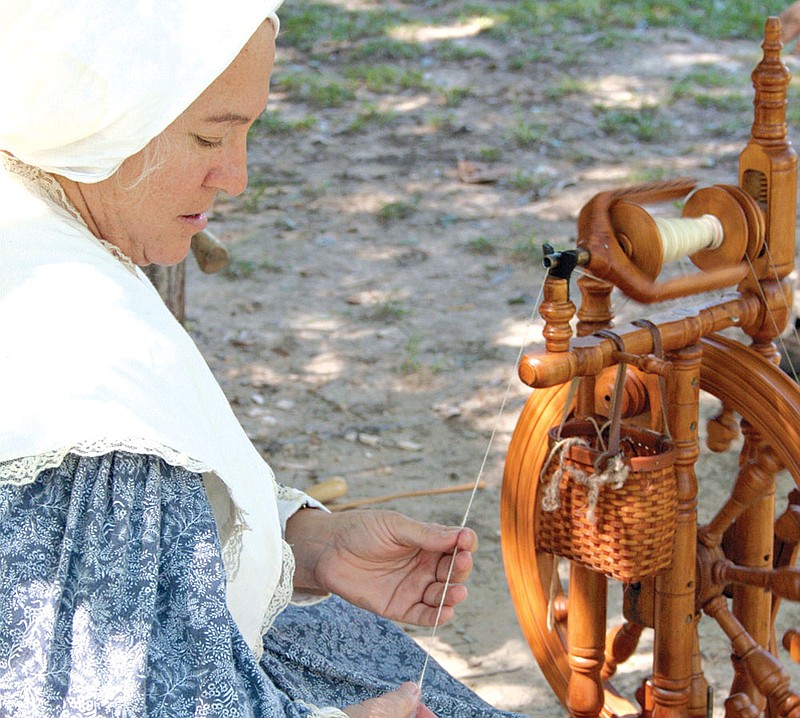SHERIDAN — Rita Layne was acting the role of a schoolmarm from the early 1900s, but she was having a hard time staying in character.
Several of the visitors to the one-room schoolhouse preserved at the Grant County Museum could remember attending similar schools, and they kept interrupting the teacher with stories of their own.
Layne was one of more than a dozen re-enactors at Heritage Square, a shady yard next to the museum in Sheridan, where 10 old buildings from Grant County communities have been placed to feature and demonstrate how people worked and lived in the past.
Grant County Heritage Days, held Saturday, allowed visitors to experience making fire before the days of matches, carving kitchen utensils by hand from wood, trading for needed items by bartering and other activities that were common before modern technology played such a huge role in life.
“We hope we can show people things they may have heard about but have never seen,” said D.J. Wallace, director of the Grant County Museum.
In the schoolhouse, Layne explained the school had closed on a snowy day in 1915.
“We left in such a hurry, we didn’t finish cleaning the blackboard,” she said, playing the role of the teacher who was at the school on the actual day the school closed for good.
Layne went over the chores students had to do every morning before classes could begin. Those included drawing water from the well, cutting firewood and beating the erasers to remove chalk dust.
The teacher also explained that her duties, as described in a notebook by the school board, included starting a fire in the stove on cold mornings, sweeping the floors every day and mopping them once a week.
The rules also included the teacher’s deportment.
“A teacher could not smoke, could under no circumstances dye their hair, loiter at the ice cream shop and never ride in a carriage or automobile with a man not your father or brother,” Layne read to her class of visitors.
Ree Walker of Damascus was making thread on a foot-pedal-powered spinning wheel under the trees on Heritage Square.
“It takes about a year to grow and harvest, then process, cotton or flax, or gather wool from sheep,” Walker said. Then you comb it out and spin it into thread. Then I have to weave it into cloth so I can cut and sew it to make a shirt or a skirt.”
Walker said she has been spinning thread and weaving cloth for about eight years as a re-enactor but that it has been her hobby for more than 20 years.
“The first time I had to cut a cloth I had spun and then weaved, it hurt,” she said, “but I remembered that this is what I did it for in the first place.”
Dressed in 19th-century clothing, some of which she made herself, she kept the spinning wheel going as she made thread as people watched.
Next to her was her husband, Tom Walker, originally from Kentucky, who was carving a wooden spoon from a piece of pecan wood. Without using modern tools to drill or turn the wood,
it can take days of work to create one spoon or some other kitchen utensil.
Tom was also working on a bowl made from sweet-gum wood, which is much harder than it looks, he said.
“It is a soft wood, but the grain is strong and can change directions,” he said. “It is very hard to carve.”
Nearby, Mike Bethea of Maumelle was making rope with a hand-cranked device.
“This machine was invented in the early 1800s, and it makes rope by spinning, rather than braiding by hand,” he said. “This is basically how rope is still made, but now it is all machine-powered.
Bethea said he is a member of the Early Arkansaw Reenactors, a group that preserves and demonstrates skills used before 1840.
The four-hour Heritage Days drew a few hundred people, Wallace said.
“We have so much to see here, and we try to get the word out to everyone,” he said.
Along with all the activity on the square, the Grant County Museum was open with no admission fee. The museum offers rooms of artifacts of country life in Grant County, as well as displays covering law enforcement, schools and prominent people within the county’s communities.
There are detailed military displays covering the Civil War, especially the Battle of Jenkins Ferry, fought in Grant County; weapons and memorabilia collected by the county’s veterans of the World Wars; and a large display of military vehicles.
Staff writer Wayne Bryan can be reached at (501) 244-4460 or wbryan@arkansasonline.com.
